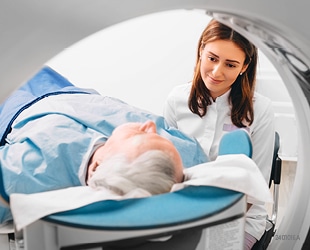Imaging May Show Early Benefits of Immunotherapy for Melanoma Patients
Non-invasive scanning for biomarkers after only 1 week may guide treatment for some patients with melanoma and avoid surgery in other patients.

Imaging may help determine if the immunotherapeutic pembrolizumab (Keytruda) is helping patients with advanced melanoma as soon as a week after treatment is started, instead of the three months that is now standard, according to results published in Clinical Cancer Research, a journal of the American Association for Cancer Research (AACR).
The goal of the study was to identify a noninvasive imaging biomarker that could guide the management of patients on these therapies and avoid toxicity in patients not likely to benefit.
“While the results need to be validated, this has the potential to be broadly applicable and offer physicians the ability to deescalate therapy or avoid surgery in patients who are responding, identify nonresponders who may need an escalation of therapy, and to be used in phase I clinical trials to test if a therapy is working,” explained Michael D. Farwell, MD, an associate professor of radiology at the Hospital of the University of Pennsylvania and corresponding author of the study.
Dr. Farwell and colleagues used FDG, a radioactive tracer that shows up in PET/CT (positron emission tomography and computed tomography) scanning, to determine if metabolic changes in a patient’s tumors could be seen after a week on the immunotherapy.
When an immunotherapy is working, immune cells get into a tumor, and the scans are expected to first show an increase in FDG activity, which Dr. Farwell calls a metabolic flare. As the tumor responds to therapy, the tumor cells die and pass back through a stable metabolism phase and ultimately end at a metabolic response, indicated by a decrease in FDG activity.
“If you’re imaging after three weeks, you’re unlikely to catch this flare, because response to immunotherapy happens so quickly and, in some cases, it’s already done—there’s no tumor left,” Dr. Farwell explained. “The other nice thing about imaging at a week is we are looking at this response curve over a pretty short interval. If you wait to monitor progress over longer intervals, it means the tumor has more time to grow in nonresponders, which can complicate the analysis.”
The researchers recruited 21 patients with advanced melanoma, with at least one measurable lesion, scheduled to start taking pembrolizumab. FDG PET/CT imaging was performed on each patient within four weeks before the start of therapy and then about one week after the first dose of pembrolizumab. Two patients did not complete both scans, so their results were excluded.
During the trial, FDG activity for each lesion was measured using the maximum standardized uptake value. A metabolic flare (MF) or metabolic response (MR) was identified in 55% of the patients who responded to treatment (6 out of 11) and none of patients who did not respond (0 out of 8). An MF or MR also correlated to longer survival with 83% of the MF-MR group seeing overall survival of three years compared to 62% in the group with stable metabolism. Additionally, median PFS was greater than 38 months in the MF-MR group and 2.8 months in the group with stable metabolism.
Limitations of the study include a relatively small sample size from a single institution, which did not include patients with stable disease. Also, there were variable intervals between a patient’s first scan prior to therapy initiation and their scan after therapy initiation. Additionally, four different PET/CT scanners were used, which could have caused variability in measurements of the lesions.
